Osmosis is the movement of water molecules through a semipermeable membrane from a less concentrated to a more concentrated solution․ It is a vital biological process that regulates fluid balance in cells․ This experiment uses gummy bears to demonstrate osmosis, as their gelatin structure acts like a semipermeable membrane, absorbing or losing water based on the surrounding solution’s concentration․
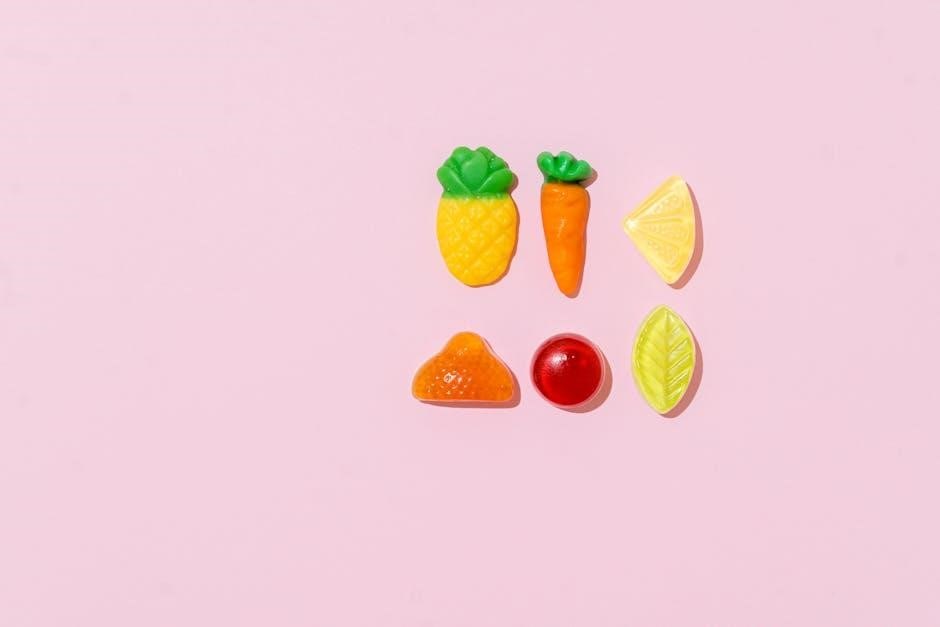
1․1 Definition of Osmosis
Osmosis is the passive transport of water molecules from a region of lower solute concentration to a region of higher solute concentration through a semipermeable membrane․ This process equalizes solute concentrations on both sides of the membrane․ In the context of the gummy bear experiment, osmosis occurs when water molecules move into or out of the gummy bear, which acts as a semipermeable membrane due to its gelatin structure․ The movement of water depends on the concentration gradient between the gummy bear and the surrounding solution, demonstrating how osmosis regulates fluid balance in biological systems․ This phenomenon is essential for understanding cellular processes and is vividly illustrated by the gummy bear’s size changes when soaked in different liquids․
1․2 Importance of Osmosis in Biological Systems
Osmosis is crucial for maintaining proper fluid balance within cells, regulating the movement of nutrients and waste․ It helps cells absorb essential nutrients and expel harmful substances․ In animals, osmosis aids in maintaining blood pressure and kidney function․ In plants, it supports water uptake through roots and nutrient transport; The gummy bear experiment simplifies this complex process, showing how osmotic pressure affects water movement․ This understanding is vital for various biological and medical applications, such as intravenous fluid administration and preserving foods․ By studying osmosis, we gain insights into cellular health and the mechanisms that sustain life․ This experiment provides a hands-on way to explore these principles in an engaging manner․
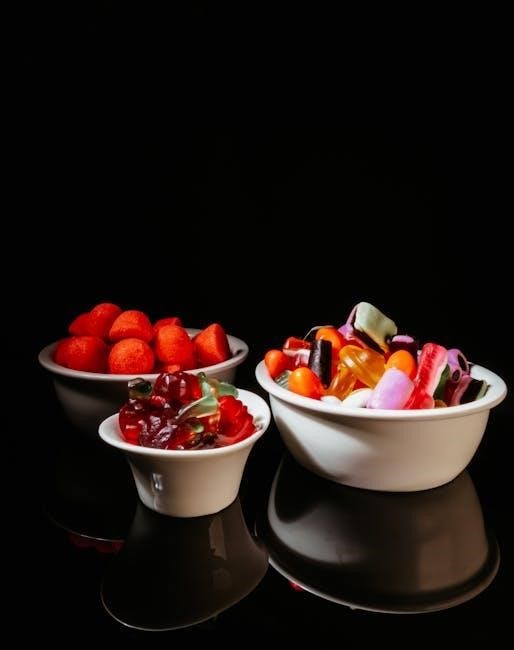
Gummy Bears as a Model for Osmosis
Gummy bears, made of gelatin and sugar, act as a model for osmosis due to their gelatin structure, which mimics a semipermeable membrane, allowing water absorption․
2․1 Composition of Gummy Bears
Gummy bears are primarily made of gelatin, a polymer that forms a three-dimensional matrix, and sugar, which contributes to their chewy texture․ The gelatin structure traps water molecules, creating a gel-like consistency․ This composition makes gummy bears an ideal model for demonstrating osmosis, as their gelatin matrix acts as a semipermeable membrane․ When placed in different solutions, water molecules can pass through the gelatin matrix, while larger sugar molecules remain trapped․ This property allows gummy bears to absorb or lose water based on the concentration of the surrounding solution, mimicking the behavior of cells in biological systems․ Their simple structure and observable changes make them a practical tool for educational experiments on osmosis․
2․2 How Gummy Bears Demonstrate Osmosis
Gummy bears effectively demonstrate osmosis through their interaction with various solutions․ When submerged in water, the gelatin matrix absorbs water molecules, causing the bear to swell․ Conversely, in a concentrated solution like salt water, water molecules are drawn out, shrinking the bear․ This process mirrors osmosis in living cells, where water moves across a semipermeable membrane․ The visible changes in size and texture make gummy bears an engaging and accessible model for understanding this biological phenomenon․ By observing these changes, students can visualize how solute concentration affects water movement, reinforcing the concept of osmosis in a hands-on and relatable way․
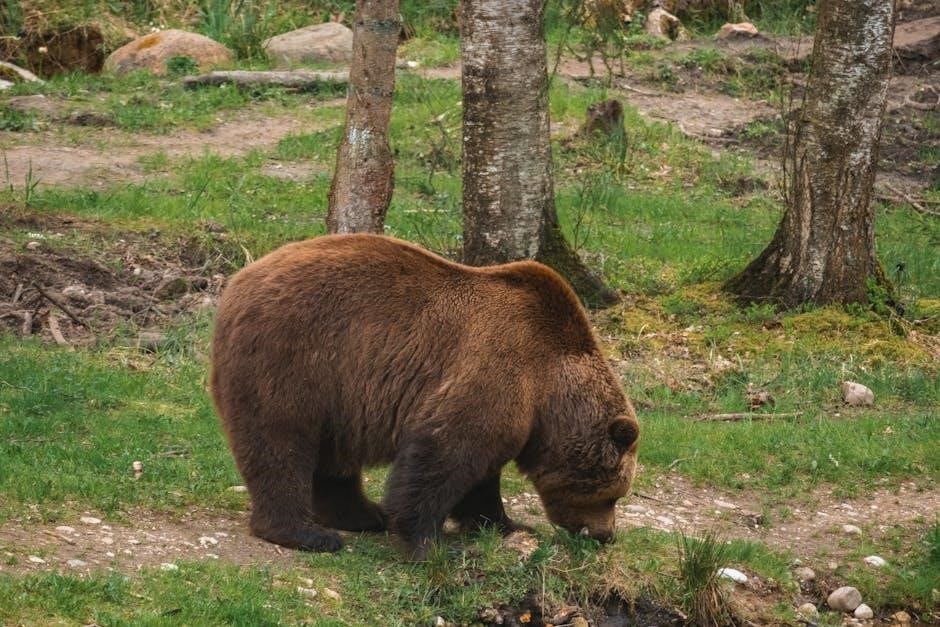
Materials Needed for the Experiment
- Gummy bears
- Distilled water
- Salt water
- Vinegar
- Measuring tools (balance, ruler)
- Containers for soaking
3․1 Gummy Bears
Gummy bears are the primary material in this experiment, serving as a model for observing osmosis․ They are made of gelatin, starch, and sugar, which form a semi-permeable membrane․ This membrane allows water molecules to pass through while retaining larger particles like sugar․ The gelatin structure absorbs water when placed in a hypotonic solution, causing the gummy bears to swell, and loses water in hypertonic solutions, leading to shrinkage․ Their chewy texture and ability to absorb liquids make them an ideal choice for demonstrating osmotic processes․ Gummy bears are readily available, cost-effective, and provide clear, measurable results for this experiment․
3․2 Liquids for Testing (Water, Salt Water, Vinegar, etc․)
Various liquids are used to test the osmotic effects on gummy bears, including water, salt water, vinegar, corn syrup, and baking soda solutions․ Water acts as a hypotonic solution, causing the gummy bears to absorb water and swell․ Salt water, being hypertonic, draws water out, shrinking the gummy bears․ Vinegar introduces acidity, potentially altering the gelatin structure․ Corn syrup, a supersaturated sugar solution, creates a highly concentrated environment, while baking soda solutions test alkalinity․ These liquids provide diverse concentrations and properties, allowing for comprehensive observation of osmotic effects․ By testing multiple liquids, the experiment demonstrates how solute concentration and pH influence water movement through the gummy bears’ semi-permeable membrane․
3․3 Measuring Tools (Balance, Ruler, etc․)
Accurate measurements are crucial for tracking changes in gummy bears during the osmosis experiment․ A balance is used to measure the initial and final mass of the gummy bears, providing data on water absorption or loss․ A ruler is essential for measuring changes in length and width, helping calculate volume changes․ Additional tools like a timer ensure consistent soaking periods, while a graduated cylinder can measure the exact volume of liquids used․ These tools allow for precise data collection, enabling students to analyze and compare results effectively․ Proper use of measuring tools ensures reliable and reproducible experimental outcomes, making the osmosis demonstration both educational and engaging․
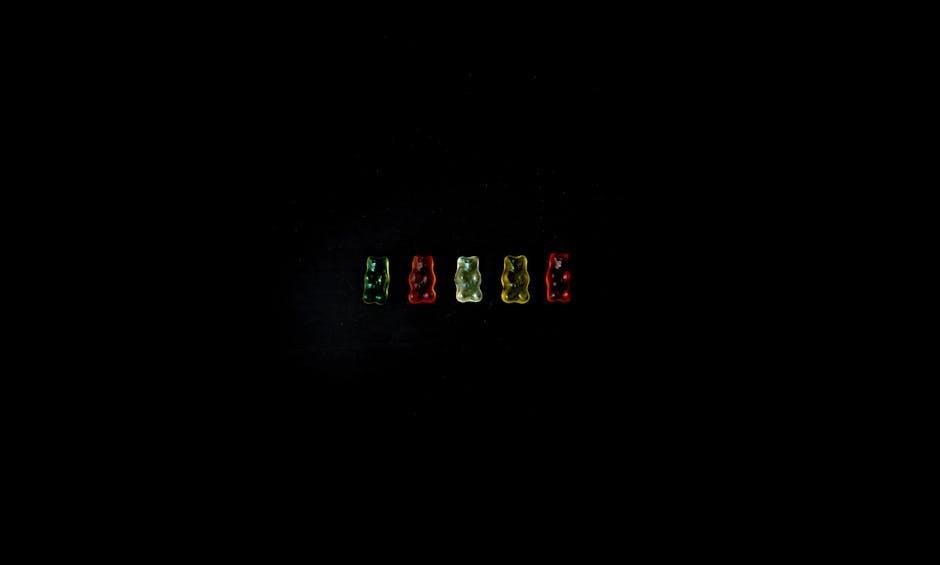
Step-by-Step Procedure
Measure gummy bears, submerge in selected liquids, and observe changes over time․ Record initial and final mass and size to analyze osmosis effects․
4․1 Preparing the Gummy Bears
Begin by selecting and rinsing the gummy bears to remove any surface residue․ Use a balance to measure their initial mass and a ruler to record their size․ Ensure the gummy bears are dry before measurement to avoid inaccuracies․ Label each gummy bear to track which liquid it will be submerged in․ If using multiple liquids, prepare separate gummy bears for each solution to prevent cross-contamination․ Once measured and labeled, the gummy bears are ready to be placed in their respective liquids for the osmosis process to begin․ Proper preparation ensures consistent and accurate results for the experiment․
4․2 Setting Up the Experiment
Fill separate containers with the selected liquids, such as tap water, salt water, vinegar, or sugar water․ Label each container to identify its contents․ Place one gummy bear into each liquid, ensuring it is fully submerged․ Cover the containers to prevent contamination and evaporation․ Set aside a control gummy bear that will not be submerged in any liquid․ Allow the gummy bears to soak for 24 hours to observe the full effects of osmosis․ Ensure the containers are kept at room temperature and away from direct sunlight․ This setup allows for clear observation of how different solutions affect the gummy bears through osmosis․
4․3 Observing and Recording Results
After soaking, remove the gummy bears from the liquids and gently pat them dry with a paper towel․ Observe and record changes in size, shape, and texture․ Measure the mass and length of each gummy bear using a balance and ruler․ Note any visible differences, such as swelling or shrinking․ Take photographs to visually document the changes․ Record all measurements and observations in a data table․ Compare the results from different liquids to see how they affect the gummy bears․ This step helps identify patterns and draw conclusions about the osmosis process․ Ensure all data is accurate and organized for further analysis․
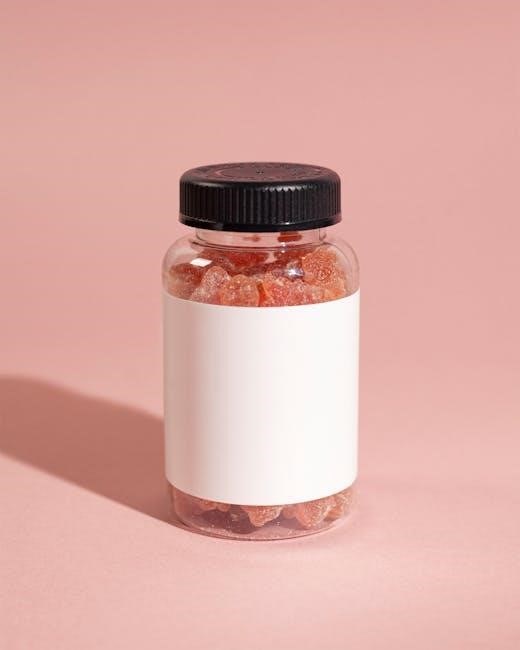
Scientific Background
Osmosis is driven by water potential, moving molecules through a semipermeable membrane․ Gummy bears, made of gelatin, act as a model, demonstrating how water enters or exits based on solute concentration, mimicking biological cells’ behavior․
5․1 Semi-Permeable Membranes
A semi-permeable membrane allows certain molecules to pass through while restricting others․ In the gummy bear experiment, the gelatin structure serves as this membrane․ It permits water molecules to enter or exit but prevents larger sugar molecules from leaving․ This selective permeability is crucial for observing osmosis, as it creates a concentration gradient that drives water movement․ The membrane’s properties mimic those of biological cell membranes, making gummy bears an effective model for demonstrating osmotic processes․ By controlling the flow of substances, the semi-permeable membrane plays a central role in the experiment’s success and its ability to illustrate key scientific concepts․
5․2 Role of Solutes in Osmosis
Solutes play a crucial role in osmosis by determining the concentration gradient that drives water movement․ In the gummy bear experiment, solutes in the surrounding liquid influence whether water enters or exits the bear․ A higher solute concentration outside the gummy bear, such as in salt water, causes water to move out, shrinking the bear․ Conversely, in a low solute concentration solution like distilled water, water flows into the gummy bear, increasing its size․ This clear demonstration of solute-driven osmotic processes highlights their significance in understanding how cells manage water balance in various biological systems, showcasing the fundamental principles of osmosis effectively․
Hypothesis and Predictions
Gummy bears will absorb water in hypotonic solutions like distilled water, swelling in size, while losing water in hypertonic solutions like salt water, shrinking visibly․
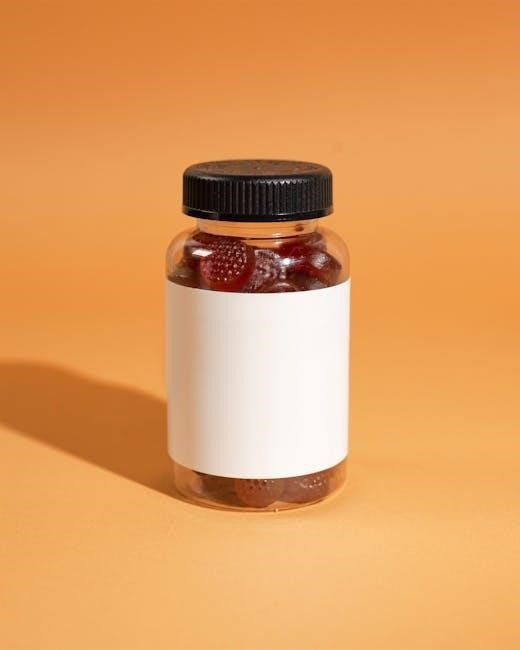
6․1 Expected Outcomes
In the gummy bear osmosis experiment, it is expected that gummy bears placed in distilled water will absorb water, leading to an increase in size and mass․ Conversely, gummy bears soaked in saltwater will lose water, resulting in a smaller, shriveled appearance․ The gummy bear in vinegar may expand slightly due to the acidic environment, but the effect will be less pronounced compared to water․ These changes occur because the gelatin in gummy bears acts as a semipermeable membrane, allowing water molecules to pass while retaining larger sugar molecules․ The movement of water is driven by the concentration gradient between the gummy bear and the surrounding solution․ Observing these changes provides a clear visual representation of osmosis in action․
6․2 Variables Affecting the Experiment
The gummy bear osmosis experiment is influenced by several variables, including the type of liquid used, the duration of soaking, and the initial size of the gummy bears․ The concentration of solutes in the liquid, such as salt or sugar, affects the rate of water movement․ Higher solute concentrations in the liquid result in greater water loss from the gummy bear, while pure water causes the bear to swell․ Temperature may also play a role, as it can influence the rate of molecular movement․ Additionally, the gummy bear’s surface area and the presence of additives like vinegar can impact the results․ These variables must be controlled to ensure consistent and reliable outcomes․
Results and Data Analysis
Gummy bears soaked in water swelled due to water absorption, while those in salt or sugar solutions shrank․ The concentration of solutes influenced mass and volume changes․
7․1 Changes in Gummy Bear Size
After soaking, gummy bears in water expanded significantly, while those in salt or sugar solutions shrunk․ The size change depended on the solution’s solute concentration․ Water absorption caused swelling in hypo-osmotic environments, whereas in hyper-osmotic solutions, water loss led to shrinkage․ The gelatin structure allowed water molecules to pass through, demonstrating osmosis visually․ Measuring the bears before and after immersion provided clear data on volume changes․ This visual representation helped illustrate how osmotic pressure drives water movement across a semipermeable membrane, mirroring biological processes like cell hydration and dehydration․ The experiment effectively used gummy bears as a simple model for observing osmotic effects․

7․2 Percent Change in Mass and Volume
The experiment revealed significant percent changes in both mass and volume of gummy bears after immersion in different solutions․ Bears soaked in water showed a substantial increase, while those in salt or sugar solutions exhibited a notable decrease․ Calculations based on initial and final measurements highlighted the extent of water absorption or loss․ The percent change was higher in water due to the gummy bears acting as hypo-osmotic agents, absorbing water rapidly․ In contrast, hyper-osmotic solutions like salt or sugar caused water to leave the bears, shrinking them․ These quantifiable changes provided clear evidence of osmosis, demonstrating how concentration gradients influence water movement across a semipermeable membrane, aligning with biological principles of osmotic pressure and fluid balance․
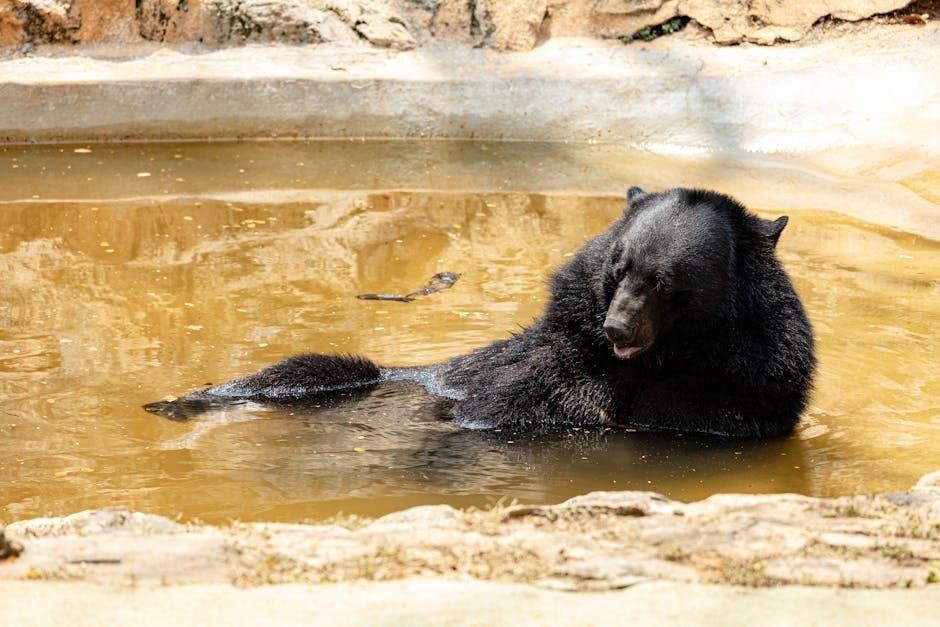
Discussion
The experiment effectively demonstrated osmosis, showing how gummy bears absorb or lose water based on solution concentration, mimicking biological processes like cell fluid balance in living organisms․ This visual representation aids in understanding osmotic principles and their real-world applications in biology and medicine, providing an engaging and educational hands-on experience for learners of all ages to grasp complex scientific concepts through simple, observable changes in gummy bears․
8․1 How Different Liquids Affect Osmosis
Different liquids significantly influence the rate and direction of osmosis in gummy bears․ Hypertonic solutions, like saltwater, cause gummy bears to shrink as water leaves the bear․ In isotonic solutions, like distilled water, minimal change occurs; Hypotonic solutions, such as tap water, result in water entering the bear, swelling it; Vinegar and baking soda solutions also affect osmosis due to their solute concentrations․ The gelatin structure of gummy bears acts as a semipermeable membrane, allowing water to pass while trapping larger molecules․ This experiment demonstrates how varying solute concentrations alter osmotic flow, mimicking biological processes like cell hydration and dehydration․ The results highlight the importance of tonicity in determining the direction of water movement, providing a clear visual representation of osmotic principles․
8․2 Real-World Applications of Osmosis
Osmosis plays a crucial role in various real-world applications, including medical treatments, agriculture, and water purification․ In medicine, osmosis is essential for dialysis, where it helps remove waste from blood, and in drug delivery systems to release medication․ In agriculture, understanding osmosis aids in soil water management and nutrient absorption by plants․ Water purification systems rely on osmosis to remove impurities through semipermeable membranes․ Additionally, the food industry uses osmosis to preserve fruits and vegetables by controlling moisture content․ This experiment with gummy bears simplifies these complex processes, making osmosis accessible for educational purposes and highlighting its importance in maintaining biological and environmental balance․ Such applications underscore the significance of osmosis in daily life and technology․
This experiment effectively demonstrates osmosis, showing how gummy bears absorb water in different solutions, providing a simple yet educational model for understanding this biological process․
9․1 Summary of Findings
The gummy bear osmosis experiment revealed significant changes in the bears’ mass and size when submerged in different solutions․ In distilled water, the gummy bears absorbed water, increasing in size due to osmosis, as water molecules entered through the semipermeable gelatin membrane․ In contrast, when placed in hypertonic solutions like salt water or vinegar, the bears lost mass, as water molecules exited the gummy bear․ This demonstrated how solute concentration affects osmotic flow․ The experiment also highlighted how gummy bears serve as an effective model for teaching osmosis, showcasing the role of solutes and the behavior of water in various environments․ These findings align with biological principles, offering insights into cellular processes and fluid balance․
9․2 Implications for Learning
The gummy bear osmosis experiment is an engaging and hands-on way to teach students about osmosis and its biological relevance․ By observing visible changes in the gummy bears, students can better grasp abstract concepts like concentration gradients and water movement․ This experiment encourages critical thinking, as students analyze how different solutions affect the bears․ It also introduces them to the scientific method, fostering curiosity and problem-solving skills․ The simplicity of the experiment makes it accessible for learners of all ages, while its clarity reinforces key principles of biology and chemistry․ This interactive approach not only enhances understanding but also sparks interest in STEM fields by connecting classroom learning to real-world phenomena․
Additional Resources
Explore detailed guides and PDFs on the gummy bear osmosis experiment, including lab manuals and activity sheets, available online for deeper understanding and educational purposes․
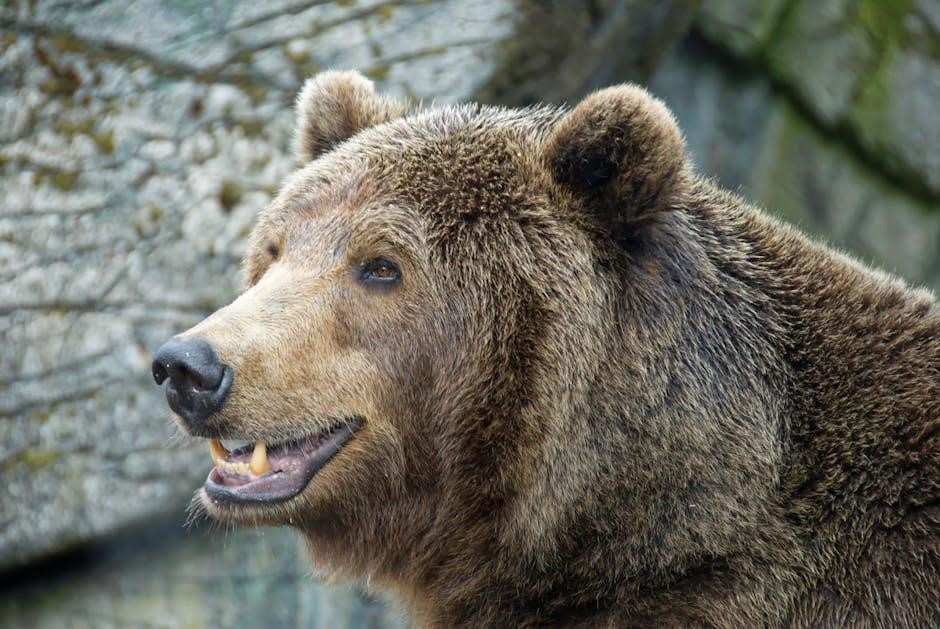
10․1 Recommended Reading
For a deeper understanding of the gummy bear osmosis experiment, explore the following resources:
– Gummy Bears and Osmosis by Michigan․gov provides a detailed lab manual․
– Sciencedipity UK offers a comprehensive guide with step-by-step instructions․
– Growing Gummy Bear Food Science explains the science behind the experiment․
– Osmosis with Gummi Bears includes activities for students to visualize water movement․
These resources are available as downloadable PDFs and offer insights into osmosis, ideal for educators and students seeking hands-on learning experiences․ They include visuals, data analysis tips, and real-world applications, making complex concepts accessible and engaging for all ages․
10․2 Links to PDF Guides
Access detailed PDF guides to enhance your understanding of the gummy bear osmosis experiment:
– Michigan․gov’s Gummy Bears and Osmosis Lab Manual provides step-by-step instructions and scientific background․
– Sciencedipity UK’s Gummy Bear Osmosis Guide offers visuals and data analysis tips․
– Oregon State University’s Gummy Bear Osmosis Lab includes activities for students․
These PDFs are ideal for educators and students, offering comprehensive insights into osmosis and its real-world applications through engaging experiments․
